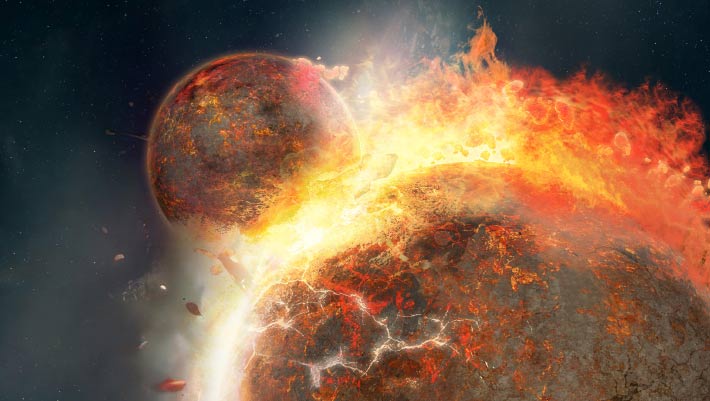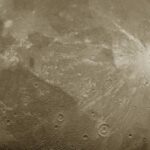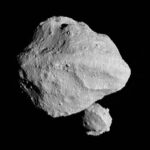A giant collision between the ancient protoplanet Theia and the proto-Earth about 4.5 billion years ago may have formed Earth’s Moon as well as two continent-sized regions — formally known as large low-velocity provinces — within Earth’s mantle, according to a research team led by Caltech scientists.
Yuan et al. suggest that LLVPs are remnants of the ancient protoplanet Theia that violently collided with Earth billions of years ago in the same giant impact that created our Moon. Image credit: Hernán Cañellas.
In the 1980s, scientists discovered two continent-sized blobs of unusual material deep near the center of the Earth: one beneath the African continent and one beneath the Pacific Ocean.
Each blob is twice the size of the Moon and likely composed of different proportions of elements than the mantle surrounding it.
Where did these strange blobs — formally known as large low-velocity provinces (LLVPs) — come from?
“Terrestrial planet formation concludes with a number of giant impacts among Moon- and Mars-sized planetary embryos,” said Caltech researcher Qian Yuan and colleagues.
“The well-studied giant-impact scenario involves a protoplanet, Theia, colliding with proto-Earth.”
In the study, the authors used computer simulations to propose an explanation for LLVPs.
The material in these regions has been suggested to be between 2.0 and 3.5% denser than the surrounding mantle.
The simulations show that LLVPs may represent buried relics of Theia mantle material that was preserved in proto-Earth’s mantle after the Moon-forming giant impact.
These Theia relics are proposed to have been tens of kilometers across, and the authors suggest that they sunk to the lower region of the mantle and accumulated to form dense blobs above the Earth’s core.
“A logical consequence of the idea that the LLVPs are remnants of Theia is that they are very ancient,” said Dr. Paul Asimow, also of Caltech.
“It makes sense, therefore, to investigate next what consequences they had for Earth’s earliest evolution, such as the onset of subduction before conditions were suitable for modern-style plate tectonics, the formation of the first continents, and the origin of the very oldest surviving terrestrial minerals.”
“Our findings challenge the traditional notion that the giant impact led to the homogenization of the early Earth,” said Professor Hongping Deng, a researcher at the Shanghai Astronomical Observatory.
“Instead, the Moon-forming giant impact appears to be the origin of the early mantle’s heterogeneity and marks the starting point for the Earth’s geological evolution over the course of 4.5 billion years.”
“The Moon appears to have materials within it representative of both the pre-impact Earth and Theia, but it was thought that any remnants of Theia in the Earth would have been ‘erased’ and homogenized by billions of years of dynamics (e.g., mantle convection) within the Earth,” said Arizona State University’s Professor Steven Desch.
“This is the first study to make the case that distinct ‘pieces’ of Theia still reside within the Earth, at its core-mantle boundary.”
“It appears that Earth’s blobs are remnants of a planetary collision that formed our Moon,” said Arizona State University’s Professor Ed Garnero.
“In other words, the massive blobs currently inside Earth, deep beneath our feet, are extraterrestrial. Earth not only has ‘blobs,’ Earth has extraterrestrial blobs!”
“Through precise analysis of a wider range of rock samples, combined with more refined giant impact models and Earth evolution models, we can infer the material composition and orbital dynamics of the primordial Earth, Gaia, and Theia,” Dr. Yuan said.
“This allows us to constrain the entire history of the formation of the inner Solar System.”
“This research even provides inspiration for understanding the formation and habitability of exoplanets beyond our Solar System,” Professor Deng said.
The study was published in the journal Nature.
_____
Q. Yuan et al. 2023. Moon-forming impactor as a source of Earth’s basal mantle anomalies. Nature 623, 95-99; doi: 10.1038/s41586-023-06589-1




